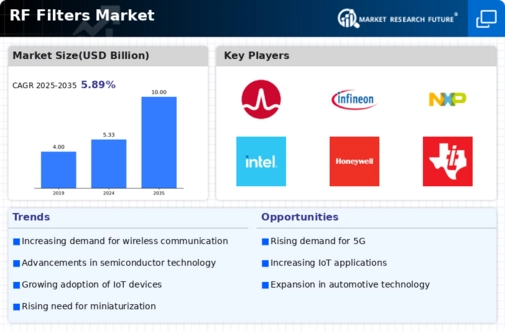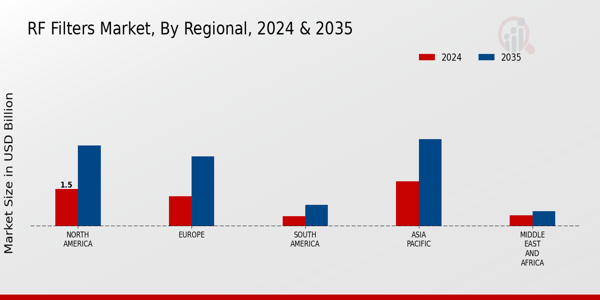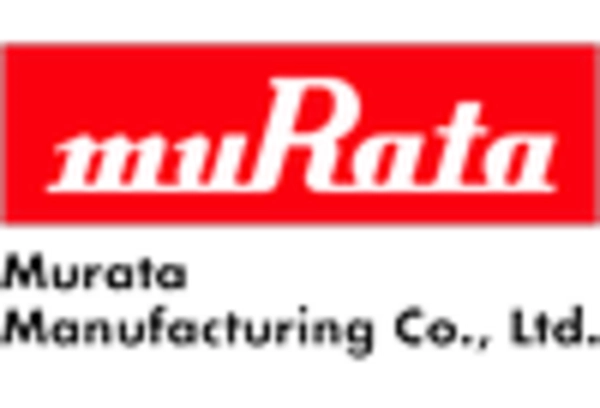Emergence of Smart Cities
The RF Filters Market is poised for growth as the concept of smart cities gains traction. The development of smart city infrastructure necessitates the deployment of advanced communication networks, which in turn drives the demand for efficient RF filters. As cities implement IoT devices and smart technologies to enhance urban living, the need for reliable RF filtering solutions becomes critical to manage the vast amounts of data generated. The market is expected to benefit from government initiatives aimed at promoting smart city projects, which could lead to increased investments in RF filter technologies. This trend suggests a promising future for the RF filters market, as stakeholders recognize the importance of robust filtering solutions in supporting the connectivity and functionality of smart city ecosystems.
Expansion of Consumer Electronics
The RF Filters Market is significantly influenced by the expansion of the consumer electronics sector. With the increasing adoption of smart devices, including smartphones, tablets, and wearables, the demand for high-performance RF filters is on the rise. In 2025, the consumer electronics segment is expected to account for a substantial share of the RF filters market, driven by the need for enhanced connectivity and improved user experiences. As manufacturers strive to integrate advanced features into their products, the role of RF filters becomes critical in ensuring optimal performance and reliability. This trend is likely to propel investments in research and development, leading to the introduction of innovative RF filter technologies that meet the stringent requirements of modern consumer electronics.
Growth in Automotive Applications
The RF Filters Market is witnessing a transformation due to the increasing integration of RF filters in automotive applications. As vehicles become more connected and autonomous, the demand for reliable RF filtering solutions is escalating. The automotive sector is projected to experience a CAGR of around 8% in the adoption of RF filters, driven by the need for enhanced communication systems, including vehicle-to-everything (V2X) technologies. These systems require robust RF filters to ensure seamless connectivity and minimize interference from various electronic components within the vehicle. Consequently, automotive manufacturers are increasingly collaborating with RF filter suppliers to develop tailored solutions that meet the specific needs of modern vehicles, thereby driving growth in the RF filters market.
Rising Demand for Wireless Communication
The RF Filters Market is experiencing a notable surge in demand due to the increasing reliance on wireless communication technologies. As mobile devices proliferate, the need for efficient RF filters becomes paramount to ensure signal integrity and reduce interference. The market is projected to grow at a compound annual growth rate (CAGR) of approximately 10% over the next five years, driven by the expansion of telecommunications infrastructure. This growth is further fueled by the advent of advanced technologies such as 5G, which necessitates the deployment of sophisticated RF filtering solutions to manage higher frequencies and bandwidths. Consequently, manufacturers are focusing on developing innovative RF filter designs that cater to the evolving requirements of wireless communication, thereby enhancing the overall performance of communication systems.
Technological Advancements in RF Filter Design
The RF Filters Market is significantly impacted by ongoing technological advancements in RF filter design. Innovations such as miniaturization and the development of new materials are enabling the creation of more efficient and compact RF filters. These advancements are crucial in meeting the demands of modern communication systems, particularly in high-frequency applications. The market is likely to see a shift towards more sophisticated filter designs that offer improved performance and lower insertion loss. As manufacturers invest in research and development to enhance their product offerings, the RF filters market is expected to expand, driven by the need for cutting-edge solutions that can support the increasing complexity of communication networks.
















Leave a Comment